ADS 6523 Final
1/84
There's no tags or description
Looks like no tags are added yet.
Name | Mastery | Learn | Test | Matching | Spaced |
|---|
No study sessions yet.
85 Terms
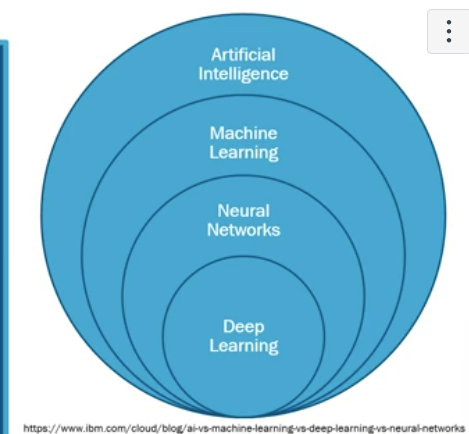
Artificial intelligence
intelligence displayed by machines, as opposed to natural intelligence demonstrated by humans and other animals. When a machine mimics cognitive functions typically associated with humans such as planning, learning, reasoning, problem solving, knowledge representation, perception, motion, manipulation, social intelligence, and creativity
Machine learning
a branch of artificial intelligence that uses algorithms for statistical prediction and inference and allows computer algorithms to progressively learn from senor big data sets and improve themselves accordingly, eliminating the need for a human data analyst.
Characteristics of Machine learning
different than data mining (which gleans information from databases by finding patterns)
ML teaches the computer how to make sense of the data (trained on a training dataset, learns to make predictions about new data)
ML used in animal genetics research (to predict phenotypes based on genotypic information, identifying outliers in a population, and genotype imputation
ML used in dairy production (mastitis detection from automated milking, monitor and predict lameness, estimate body weight via image analysis, monitor microbiome health)
Neural network
a computer system of a type of computer program that is designed to copy the way in which the human brain operates
Deep learning
a type of artificial intelligence that uses algorithms (sets of mathematical instructions or rules) based on the way the human brain operates
Characteristics of Neural networks
mimic the human brain through a set of algorithms
Main components are inputs, weights, a bias or threshold, and an output
Output of one layer is passed in the next network layer
Characteristics of deep learning
a neural network taht consists of 3 or more layers (each layers includes inputs and the output)
Less dependent on human intervention and structured data to learn than machine learning (supervised learning)
Requires more data than machine learning to improve accuracy
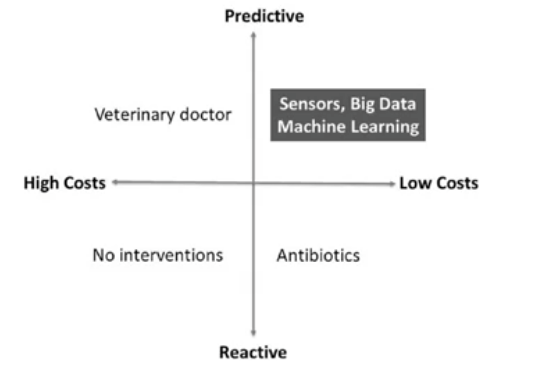
Difference between preedictive and reactive paradigms
Reactive (has already happened, less options), Proactive (what is happening), Predictive (what may happen, looking ahead)

Data analytics maturity curve
Hindsight (descriptive - what happened), insight (predictive - what will happen), foresight (prescriptive - what can happen)
Current technologies in animal agriculture
robotic milkers
wearable senors
radio frequency ID ear tags
Feed sensors
(all for individual animals and minimal human intervention)

Advanced technology collection and analysis process
sensors (capture)
Big data (processes)
Machine learning (analyzes)
Algorithm (notifies)
Benefits of advanced technology collection
facilitate collection and analysis of more diverse datasets for improved accuracy
consider variables such as genetics, environment and management priorities
develop relevant and contextually optimal solutions
reduce costs, increase production, enhance efficiencies, and create optimal formulations
provide evidence-based data and data-driven solutions
Key technical challenges in machine learning
computational complexity (challenges in algorithm selection, higher storage requirements and energy use)
Concept drifts (required adaptation to changes in data distributions within a concept)
Discrepancies in different situations (retraining of system needed when in new environment or with new animals)
Potential concerns with machine learning
insufficiently modeled algorithms (can have unintended and adverse effects)
Data outliers (example: 100 year storm data outliers)
Inherent biases in data (can effect predictive models)
technology convergence
blurring of the boundaries between disjoint areas of science, technology, markets, or industries. Synonyms are technology fusion, merging, cross fertilization, hybridization, and overlap
Where 2 or more independent technologies integrate and form a new outcome
Merging, blending, integrating, and/or transforming technologies leads to a completely new converged technology
Converged technologies may replace or render obsolete single-function technologies
Progression of evoluation of technology
3 characteristics:
can execute multiple functions to serve blended purpose
can collect and use data in various formats and employ machine learning techniques to deliver enhanced user experience
Connected to a network directly and/or are interconnected with other devices to offer ubiquitous access to users
IOT (internet of things) is actually a
covergence of technologies
Upper layers are made of
users interact more with these layers
Tech convergence takes science and leads to
solutions
Technology convergence includes fusing information from multiple sensors
data fusion is based on the independent observation data of multiple sensors. More effective information can be obtained through composite application and algorithm design, to eliminate the limitation that a single sensor can only obtain partial information of detection target
Features of multi-sensor fusion technology
strong environmental adaptability
wide perception dimension
high measurement accuracy
fast processing speed
complex structure
Smart farming vs. precision ag
both precision ag and smart farming refer to the use of modern technologies such as the Internet of Things (IOT), drones, robotics and Artificial intelligence (AI) in the control and management of farms in order to improve productivity adn yield, while reducing input, land, and labor requirements
PA is distinct from SF in that it specifically refers to IOT-based approaches aiming at improving the efficiency of input use through providing farmers with tools that increase the granularity of decision making
Precision livestock farming (PLF)
management of individual animals by continous automated real-time monitoring of livestock production/reproduction, health, welfare, and environmental impact
Complex, individual, and time variant (CIT) system
a complex, individually different and time variant system; applies to all living organisms, including animals
Bioresponse
the biological response of an animal when exposed to external stimuli
Animal variable
any parameter related to the behavioral or physiological state of the animal (like weight, activity, feed intake,; typically acquired in the field)
Feature variable
variable that may be calculated based on measured animal variables and that describes the bio-response of interest
Target variable
variable that is derived from feature variables and that relates to the final objective of the PLF method; used as foundation for making management decision
Gold standard
reliable and/or generally accepted method of measuring or observing target variables; may be expensive, complex, and difficult to asses, but as necessary to verify that a PLF method provides reliable outputs
Considerations specific to animals to account for in PLF
animal observation and monitoring is more challenging (animals at times display complex behaviors that may be difficult to observe and intepret)
animals may move or not cooperate with the manager (animal movement or lack of coopration with handlers may make implemenation of automated actions more difficult)
animal needs beyond survival are linked with certain behaviors (animals must be able to show certain behaviors and maintain a certain perceived quality of life or welfare)
Conditions that must be met to achieve favorable monitoring and control of PLF livestock production processes
continuous measurement of animal variables (the information must be analyzed continously)
availability of reliable predictions (every moment a reliable expectations must be available on how animal variables will fluctuate or animals will respond to environmental changes)
analyzing algorithm that integrates predictions and measurements (online information is used together in mathematical equations to monitor or manage animals automatically)
Realistic use of data via PLF
PLF technoligies installed in livestock houses generate a huge amount of data. Data transmission takes time, energy, and money. Sending data wirelessly involves energy dan costs. Development of real-time algorithms that calculate information from the data at the lowest possible level enable transmission of relevant information rather than data. Algorithms are needed that can calculate relevant information from the data on or close to the individual animal
3 B’s of precision livestock farming techniques
Biometrics sensors
monitor behavioral and physiological parameters of livestock allowing managers to evaluate an animal’s health and welfare over time
Can be invasive or non-invasive
Big data analytics
the acquisition (often from biometric sensors) and analysis of large, complex datasets
Used to inform management decisions
Blockchain
decentralized or distributed encrypted transactions ledger technology
What PLF technologies can facilitate
individualized animal care (provide real time alerts to deliver individualized (and even automated animal care)
Novel phenotype measurements (measure phenotypes that would be difficult to measure without digital technologies)
In-depth analysis of animals within their environment (help genetic improvement of adapted animals for different environments and development of enhanced animal facilities and equipment)
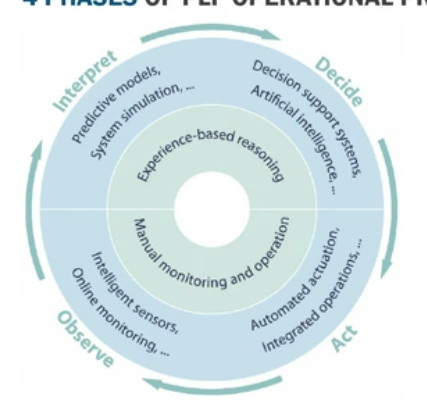
4 phases of PLF operational processes
observe (intelligent senors, online monitoring)
interpret (predicitive models, system simulations)
decide (decision support systems, artificial intelligence)
act (automated actuation, integrated operations)
inner cycle of 4 phases of PLF operational processes
represents the present state of the art industry, with manual actions and monitoring, and experience based interpretation and decision making
outer cycle of 4 phases of PLF operational processes
illustrates how the introduction of PLF may influence the different phases of the cycle
Internet of Things (IOT)
a network of objects that are connected wirelessly using sensors, and can transmit information to each other, or a wider network, without human intervention; connected objects include humans, animals, plants, and infrastructure (ex: equipment, buildings, etc.)
Sensor
a device that measures or detects a biological, chemical, physical, or mechanical property, or a combination of these properties, and records and collects the data for intepretation by a human or a machine
Acoustic sensor
measures sound, microphones convert sounds into electrical signals
Chemical sensors
measure (part of) the chemical composition of a liquid or gas environment, must recognize a chemical compound, must give information on chemical compound concentration
electrical sensor
measures electrical current and conductivity
pressure sensor
sensor consists of a thin, flexible membrance that can deform and covers a reference cavity sealed at low vacuum pressure
flow sensor
mass flow meter measures flow rate of a fluid through a tube, mass flow rate divided by fluid density to calculate volume per unit of time, volumetric flow rate determined based on fluid conductivity
mechanical sensor
measures poistion, angle or accerelation (change in velocity over time), accelerometer measures accerelation, gyroscope measures angle, inclinometer (tilt sensor, slope sensor , clinometer) measures object angle using force of gravity
temperature sensor
measures climate conditions of animal’s environment or animal body temperatures, measued mechanically (via thermometers or bimetallic strips), electrically (via thermistors, themocouples, resistance thermometers, or silicon bandgap sensors) or based on infrared radiation (via thermographic cameras)
location sensors
measured by global positioning system (GPS), radio frequency identification (RFID), radio tracking, bluetooth devices, Global System for Mobile communication (GSM) devices, or wireless local area network (WIFI)
optical, imaging, and light sensors
measured in Lumen (total amount of viable light from a light source) or Lux (total amount of light that falls on a particular surface), light sensors types include photoresistors, photodiodes, and phototransistors
Cameras sensors
detect visible light and form an image, based on optical sensors, involve vision and image recognition systems, digital cameras use software to interpret grid electrical charges generated by light conditions and determine dark and light image areas along with colors
Sensors can be
handled, attached to an animal, mounted or placed in an animal’s environment
computer vision
field that aims to describe the world through images by interpreting, reconstructing, and extracting properties from images, such as shapes, textures, densitites, and distances; also known as machine vision systems, viisual image systems, or image systems
digital image processing
capturing and translating a visual signal into a digital image; involves the conception, design, development, and enhancement of digital imaging algorithms and programs
Digital image analysis
process of extracting meaningful information from an image
Images on visible light spectrum
capture electromagnetic waves withing the visible light spectra to generate digital images, measured by standard digital cameras and/or survelliance cameras
Infrared Radiation (IR)
wavelength longer than visible light, divided into near-infreread (NIR), mid-infrared (MIR), and far-infrared (FIR), based on specific wavelength thresholds, can be used for 3D imaging spectroscopy, night vision, and thermal imaging (thermography)
3D Imaging
can be used for measurement of animal volume, surface, and gait
passive 3D imaging
stereo imaging uses 2 or more cameras to calculate the distance of a point to the cameras
structure from motion creates a disparity map between the images from a single moving camera where each image captured by the camera where each image captured by the camera is used as the distance between “cameras”. Objects of interest must be motionless
Hybrid 3D imaging
combine RGB (intensities of red, green, and blue) sensors with depth sensors
Active stereoscopy combines stereo imaging from multiple cameras with structured light to improve depth estimation
Active 3D imaging
structured light uses active emission of knwon light patterns where the illuminated surface shows structural distortions in patterns
Time of flight (TOF) and Light Detection and Ranging (LIDAR) cameras are based on signal modulation and ranging; measure distance between sensor and target object by detecting time difference from signal emitted by transmitter, reflected on target object, and captured back by receiver
Other types of imaging
hyperspectral imaging, ultrasound, x-ray, computed tomography (CT), magnetic resonance (MR), and satellite images
Body composition imaging requires
a trained operator
Livestock imaging examples
ultrasound body composition scan of a bull
thermal image of heifer using a smart phone app
satellite image of heifer locations over time within a pasture
Principles of time of flight: 3D cameras (depth sensors)
this technique measures the distance between the senor and a target obejct by detecting the time difference from the signal emitted by a transmitter, reflected on a target object, and captured back by a receiver
Internet of services (IoS)
a collaborrative business ecosystem or global market where services from diverse providers (third parties) are offered, discovered, and consumed in shared use; a future internet that detects and uses contextual information to seamlessly adapt to an unpredicted scenario, allowing the ad hoc configuration of new information and communication technology business models
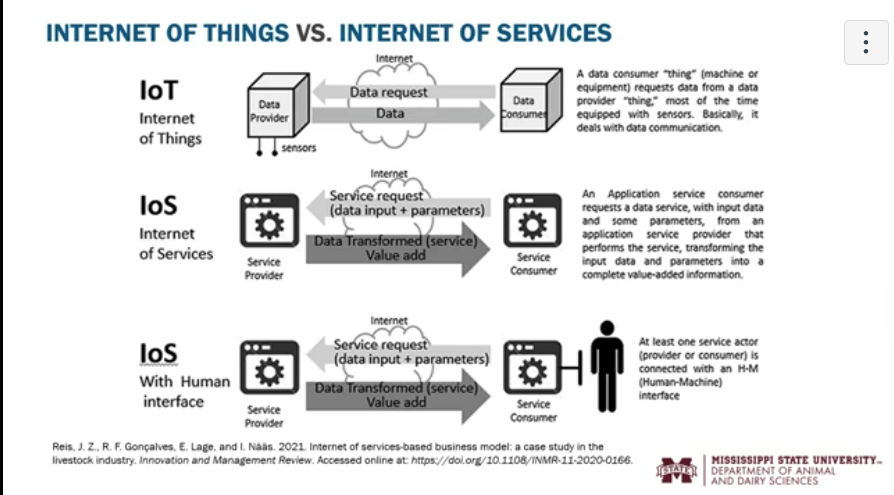
Internet of things vs. Internet of services
differences between them
Internet of Services with human interface
at least one service actor (provider or consumer) is connected with an H-M (human-machine) interface
Wearable internet of things (W-IoT)
integration of wearable devices, sensors, and communication technology in which sensors and wireless communication technology are embedded into wearable devices to collect big data for analysis and evaluation of the status of the objects monitored; an extension of Iot Technology
Features of wearable internet of things (W-IoT) technology advantageous to animal monitoring
small size, light weight, low energy consumption, convenient integration, strong adaptability, flexibility, biocompatability
Information perception not limited to environmental indicators but also animal physiological and behavioral status
Can use bioenergy and behavioral movement to realize self-power supply
Wearable microsystems attached to animal bodies can achieve precise monitoring recording, and prediction
Good maintainability and expansibility; can quickly arrange, adjust, and collect big data at almost any time, place, and environmental condition
Can facilitate intelligent control, remote management, and precise decision-making
What Precision Livestock Farming (PLF) can facilitate in horses
each horse has unique phsyiology and behavior
ability to monitor horse vital signs over long periods and during exercise can lead to the following benefits:
better performances - monitoring to tailor and fine tune training to meet individual needs ot the horse
reduced injury risks: monitoring to tailor activities, risk indentification and mitigation or avoidance
improved welfare: early disease detection, identification of abnormalities in daily behavioral patterns
Application of sensors and automated monitoring in horses: physical measures
saddle pressure
good saddle fit to disperse pressure and enhance performance
poor fit may result in back pain, injuries, poor attitude to work, and reduced performance
May be useful to measure rider position in addition to horse measures
Rein tension
quantification of applied concentrated pressure
Tension consistency
Speed of tension application and release
Application of sensors and automated monitoring in horses: physiological measures
heart rate:
cardiovascular function, and indication of mental stress
Temperature
indicator of physiologic status, welfare, and stress response
Rectal temperature
Central venous temperature as a stress indicator
Gastrointerstinal temperature
Thermal comfort of blanket-wearing horses
Respiration rate
effects of heat, exercise, and stress on thermoregulation and breathing
Application of sensors and automated monitoring in horses: behavioral measures
activity
patterns such as lying behavior (position, frequency, and duration)
Tail movements
more frequent and shorter movements may indicate foaling approaching
Head-neck position
angle with the vertical
ability to remain steady
Location
distance traveled
speed traveled
Gait analysis
lameness detection
Grazing
jaw movements

Precision livestock farming (PLF) sensors used for horses
Pressure sensor and heart rate sensor
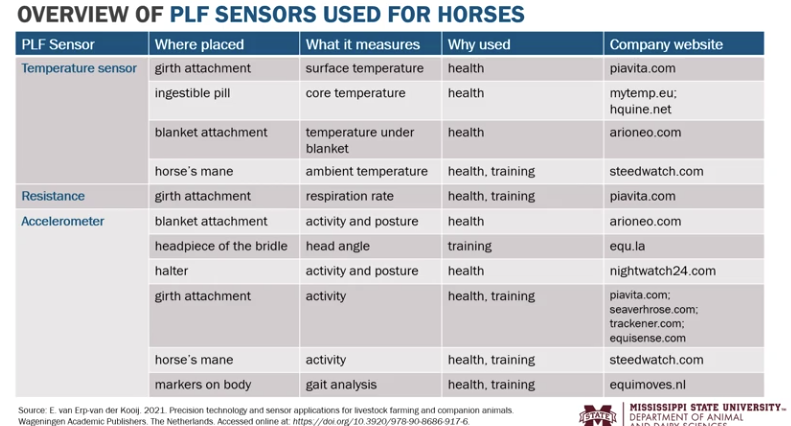
Precision livestock farming (PLF) sensors used for horses
temparature sensor, resistance, accelerometerS
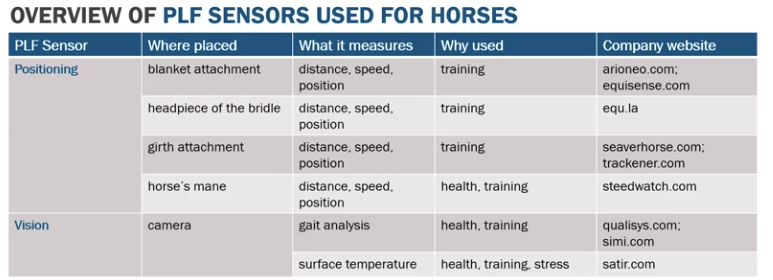
Precision livestock farming (PLF) sensors used for horses
positioning and vision
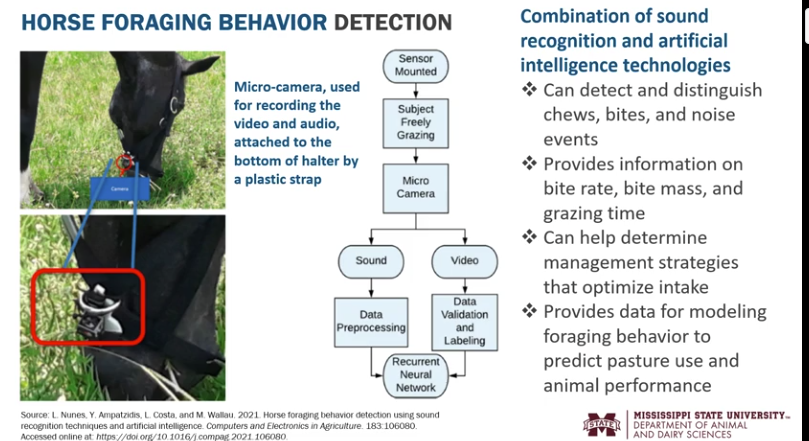
Horse foraging behavior detection
combination of sound recognition and articial intelligence technologies
can detect and distinguish chews, bites, and noise events
provides information on bite rate, bite mass, and grazing time
Can help determine management strategies that optimize intake
Provides data for modeling foraging behavior to predict pasture use and animal performance
Horse gait detection via human wearables
schematic of a system using a smart watch and smart phone to recognize horse gaits
Illustratres the concept that information about animals can be collected from measurements on humans engaged in the human-animal interface
Example of alert technology in animal applications: Foaling alert system
components
main unit/repeater
antenna/cable
pocket pager
transmitter with protective pouch to attach to mare’s halter
Features
range up to 1+ mile
future version to include optional telephone wireless dialing component
What PLF precision livestock farming technologies help address in companion animals
increasing trends on monitoring pet lifestyle and health and focus on communication between pet and owner
Concerns in the pet sector include:
Alone or in a group - socialization needs of dogs, antagonistic interactions in multi-cat households
Indoors versus outdoors - concerns about traffic accidents involving pets and behaviors when owner not home
Breeding - appropriate breeding strategies considering health concerns, behavior traits
Therapy and assistance animals - monitoring welfare of animals trained to perform specific tasks
Application of senors and automated monitoring in pets: physiological measures
heart rate
cardiovascular function and indication of mental stress
measure of activity
Temperature
indicator of health and disease incidence
rectal temperature
non-contact infrared camera detection
Respiration rate
important health indicator
effects of heat, exercise, and stress on thermoregulation and breathing
Glucose
diabetes monitoring using sensor implanted under skin
Application of senors and automated monitoring in pets: behavioral measures
activity
accelerometers used to measure activity levels
Specific behaviors and emotions
distinguish between active behaviors such as walking, trotting, galloping, eating, head shaking, sniffing, and jumping
Location and use of space
animal whereabouts and home range
finding runaways
theft deterrent
Application of senors and automated monitoring in pets: sound measures
Vocalizations (barking in dogs)
training to deter barking
distinguish emotional states
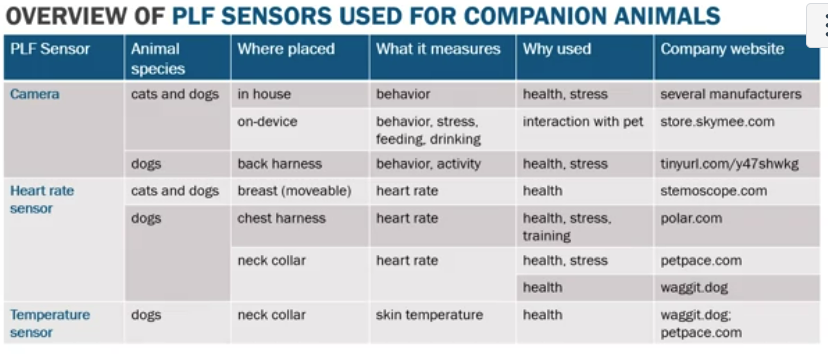
Overview of Precision livestock farming (PLF) sensors used for companion animals
camera
heart rate sensor
temperature sensor

Overview of Precision livestock farming (PLF) sensors used for companion animals
accelerometer
respiration sensor
weighing sensor
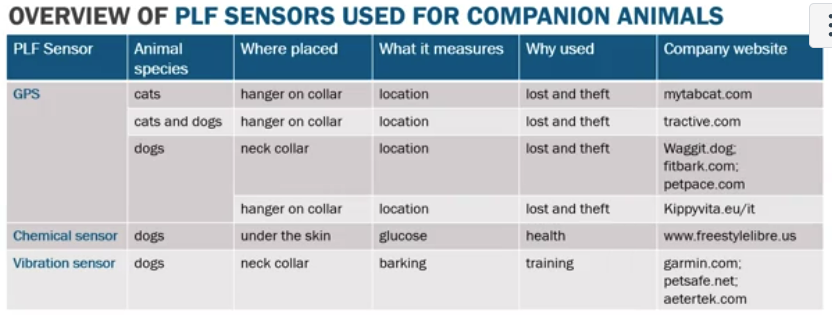
Overview of Precision livestock farming (PLF) sensors used for companion animals
GPS
Chemical sensor
Vibration sensor
Pet wearables
fitness tracker features are bonus features to the core purposes of GPS tracking devices which is to locate a pet in the event it gets separated from its caregiver
activity tracking incentives should encourage activity and friendly competition but not “overwalking” a dog
Activity tracking information can be shared with a pet’s veterinarian to give actual data instead of estimates